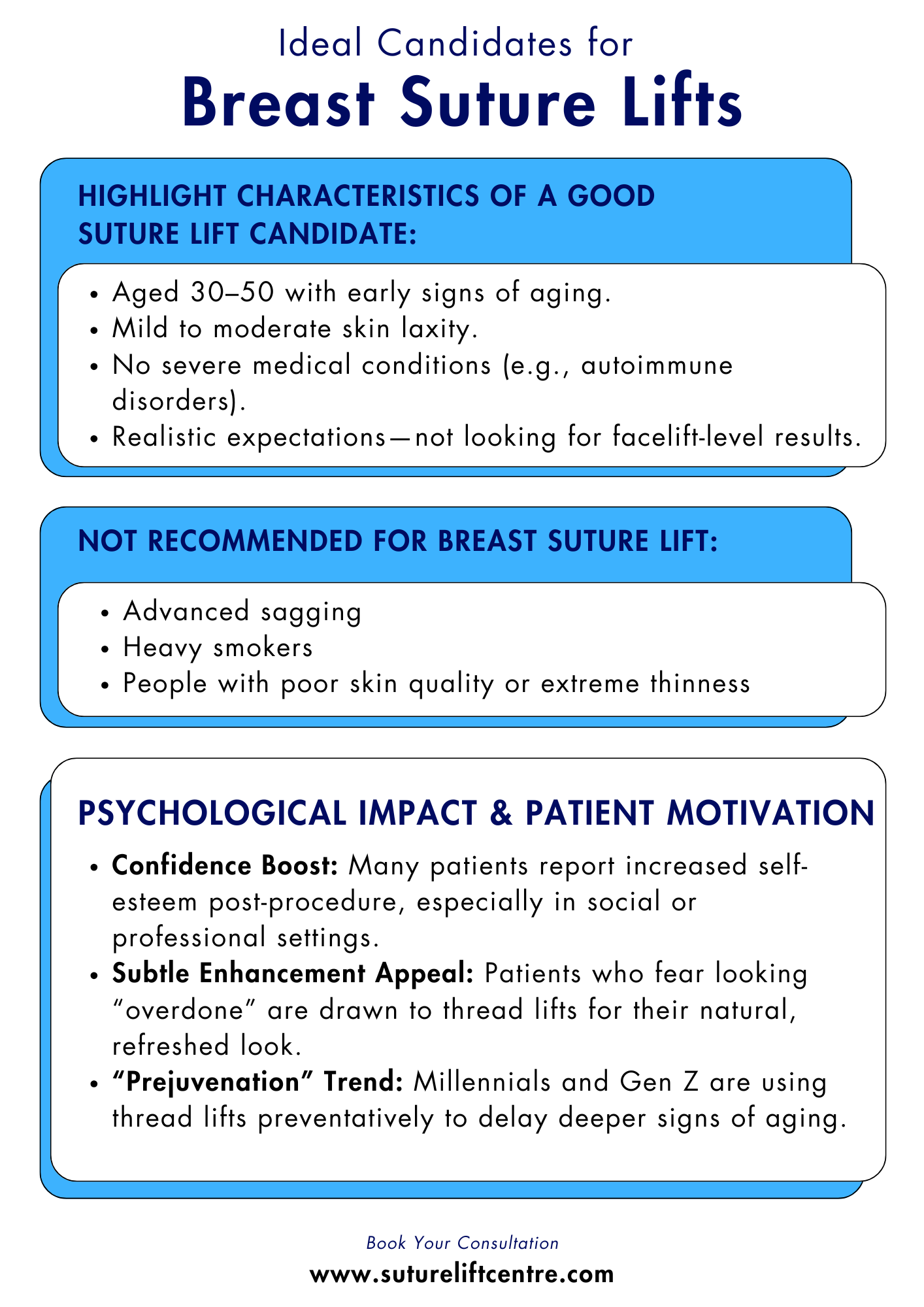Breast suture lifts are becoming a popular option for women who want a subtle lift without going through major surgery. The idea of minimal downtime and no big scars sounds appealing — but how safe is it really?
Like any cosmetic procedure, it’s not just about the results; it’s about understanding the risks, the recovery, and if it’s the right choice for you. Before you book a consultation, let’s take a closer look at what a breast suture lift actually involves — and how to know if it’s truly safe.
Key Takeaways
- Breast suture lifts are a minimally invasive procedure that can enhance breast shape.
- The safety of the procedure largely depends on the experience of the practitioner.
- While generally low-risk, there can be side effects such as swelling or infection.
- Results from suture lifts can last from 9 months to 5 years, depending on the type of threads used.
- Consultation with a qualified expert is crucial for making an informed decision.
Understanding Breast Suture Lift Procedures

Breast suture lift is a procedure designed to lift and reshape your breasts without going under the knife for a full-on surgery. Special threads are inserted under the skin to provide support and a subtle lift. It’s less invasive, which is why it’s gaining popularity.
How Does the Procedure Work?
Here’s how a breast suture lift works. First off, you’ll usually get a local anaesthetic to numb the area. Then, the practitioner will make small incisions, usually around the breast area. Using a needle, they’ll insert threads made of materials like PDO (polydioxanone) or PLLA (poly-L-lactic acid). These threads have tiny barbs or cones that grip the tissue, allowing the practitioner to gently lift and reposition the breast.
Once the threads are in place, they’re tightened to achieve the desired lift, and the ends are trimmed. The threads not only provide immediate lift but also stimulate collagen production over time, which helps to improve skin firmness. The whole thing usually takes about an hour or two, and you’re good to go home the same day.
What Are the Expected Results?
This procedure offers a subtle lift and improved breast shape, rather than a dramatic transformation. You’ll likely see a noticeable difference in the upper breast area, with a more rounded and lifted appearance. The results tend to look quite natural, which is a big plus for many people.
It’s worth noting that results can vary from person to person. Factors like skin quality, breast size, and the practitioner’s skill all play a role in the final outcome. It’s always best to have a thorough consultation to discuss your specific goals and expectations.
Safety Considerations for Breast Suture Lifts
When considering a breast suture lift, it’s natural to wonder about the safety of the materials being used. Generally, the threads employed in these procedures are made from materials like PDO (polydioxanone), which have a long history of use in medical applications, including sutures.
These materials are biocompatible but non-dissolvable, meaning they are designed to remain in the body without being absorbed over time, reducing the risk of long-term complications. It’s also worth checking that the threads used are FDA-approved, which adds another layer of reassurance.
What Are the Risks Involved?
Like any cosmetic procedure, breast suture lifts do carry some risks, although they are generally considered to be minimal. Potential complications can include:
- Infection at the insertion site
- Mild bruising or swelling
- Thread migration or extrusion (where the thread moves out of place)
- Asymmetry or unevenness in the lift
- Allergic reactions (rare, but possible)
It’s important to remember that the likelihood of these risks occurring is significantly reduced when the procedure is performed by a skilled and experienced practitioner. Open communication with your practitioner about your medical history and any concerns you have is also key to minimising risks.
How to Choose a Qualified Practitioner?
Choosing the right practitioner is arguably the most important factor in ensuring a safe and successful breast suture lift.
Here’s what to look for:
- Board certification: Check that the practitioner is a qualified and experienced cosmetic surgeon or dermatologist.
- Experience with suture lifts: Ask about their specific experience with breast suture lifts, including how many procedures they have performed.
- Before-and-after photos: Review their portfolio of before-and-after photos to get an idea of their aesthetic style and results.
- Consultation: Schedule a consultation to discuss your goals, assess your suitability for the procedure, and ask any questions you may have. A good practitioner will be happy to answer your questions and address your concerns.
- Check qualifications: Look for qualifications such as QUALIFI Level 4, 5 or 7 Aesthetic Practise to ensure a high standard of training.
Comparing Breast Suture Lifts to Traditional Methods
Let’s break down the main differences between a suture lift and traditional surgery. A suture lift is much less invasive. Traditional lifts involve cutting, removing excess skin, and reshaping the breast tissue.
Suture lifts, on the other hand, use special threads inserted under the skin to lift and support the breasts. It’s a much quicker procedure, usually done with local anaesthetic, and the recovery time is significantly shorter. The results are also different; suture lifts offer a more subtle lift, while surgery can provide a more dramatic change.
Benefits of Choosing a Suture Lift
Why might you pick a suture lift over surgery? Well, there are a few good reasons. For starters, the downtime is minimal. You could be back at work in a day or two, whereas with surgery, you’re looking at weeks of recovery.
suture lifts also leave no significant scars, just tiny entry points where the threads are inserted. Plus, it’s generally less painful than surgery. Many people like that the results look very natural. Here’s a quick rundown:
- Less invasive: No major cuts or removal of tissue.
- Faster recovery: Back to normal activities sooner.
- Minimal scarring: Tiny entry points, not large scars.
- Lower risk: Fewer potential complications compared to surgery.
Limitations of Suture Lifts
Let’s be real — suture lifts aren’t the perfect solution for everyone. One limitation is that they don’t provide the same degree of lift as traditional surgical procedures. For individuals with significant sagging, a suture lift may not achieve the desired level of improvement.
That said, not all suture lifts are the same. Some advanced suture lift techniques now offer permanent results, unlike traditional suture lifts that typically last between one to three years depending on the material used and the body’s response. With these newer options, the lift is designed to be long-lasting, eliminating the need for frequent touch-ups.
Still, suture lifts may not be suitable for everyone. Individuals with very thin skin or certain medical conditions might not be ideal candidates. Consulting with a qualified practitioner remains the best way to determine whether a suture lift — particularly a permanent one — is appropriate for your needs.
Recovery Process After a Suture Lift
What to Expect Post-Procedure?
Now, let’s talk about what the immediate aftermath looks like. It’s normal to experience some swelling and bruising. You might also feel some tenderness or discomfort, but nothing too crazy. Your surgeon will likely give you some pain relief to manage that. Just chill and follow their advice.
How Long Is the Recovery Time?
Good news: the recovery time for a breast suture lift is generally pretty quick. Most people find they’re back to their usual routine within a few days. However, it’s wise to take it easy for the first week or so. Avoid any strenuous activities or heavy lifting that could put strain on the treated area. Listen to your body, and don’t rush things.
Here’s a rough timeline:
- First 24-48 hours: Expect some swelling and bruising.
- First week: Avoid strenuous activity.
- After one week: Most normal activities can be resumed.
Tips for a Smooth Recovery
Want to make your recovery as smooth as possible? Here are a few tips:
- Keep the area clean: Gently cleanse the treated area as instructed by your surgeon.
- Apply cold compresses: This can help reduce swelling and bruising.
- Avoid sleeping on your stomach: Try to sleep on your back to avoid putting pressure on your breasts.
- Wear a supportive bra: This can help provide support and reduce discomfort.
- Follow your surgeon’s instructions: This is the most important tip of all! They know what’s best for you.
It’s important to remember that everyone’s recovery is different. Some people may experience more swelling or bruising than others. If you have any concerns, don’t hesitate to contact your surgeon. They’re there to help you every step of the way.
Long-Term Effects and Maintenance
How Long Do Results Last?
So, you’ve had your breast suture lift and you’re loving the results. Naturally, the next question is: how long will it last? Traditionally, the effects of a suture lift could be expected to last anywhere from 9 to 24 months, depending on factors like the type of threads used and the body’s natural collagen production. Some advanced threads, such as SPRING threads, have been reported to offer results lasting between three to five years.

However, with newer techniques and materials now available, certain breast suture lifts are designed to provide permanent support and lift. These options allow for long-term results without the frequent need for maintenance treatments. Of course, individual outcomes can still vary based on factors like skin quality, aging, and lifestyle habits, but permanent suture lifts have significantly changed expectations around the longevity of non-surgical lifting procedures.
What Maintenance Is Required?
Suture lifts aren’t a one-and-done deal; some maintenance helps keep things looking good. There isn’t a huge amount to do, but here’s the gist:
- Follow-up Appointments: Regular check-ins with your practitioner are a must. They can keep an eye on how things are settling and address any concerns early on.
- Healthy Lifestyle: Eating well, staying hydrated, and avoiding excessive sun exposure will help your skin stay in good condition, which supports the lift.
- Skincare Routine: A good skincare routine with products that boost collagen can also help with your maintenance.
It’s important to protect your investment. Think of maintenance as part of the overall process, not an afterthought. Small efforts can make a big difference in the long run.
Common Concerns and Questions
When it comes to suture lifts, people often worry about a few key things. Pain is usually a top concern, but most patients experience only mild discomfort during and after the procedure, which can be managed easily with over-the-counter pain relief. Another common question is about the longevity of the results. With permanent suture lifts, the lift achieved is designed to last, offering a long-term solution without the need for frequent touch-ups.
Complications like thread migration or infection are rare, especially when the procedure is performed by an experienced practitioner. Understanding the process and knowing what to expect helps ensure a smoother, more confident experience.
Consultation and Decision-Making
The consultation is the most important step. It’s where you get to grill your practitioner and see if they’re the right fit.
- Your medical history: Be upfront about everything. No point hiding anything, it could affect the procedure and your results.
- Your expectations: What do you realistically hope to achieve? A good practitioner will tell you what’s possible and what isn’t.
- The procedure itself: Ask about the type of threads used, the technique, and the potential risks.
- Costs: Get a clear breakdown of all the costs involved, so there are no nasty surprises later.
How to Prepare for the Procedure?
Okay, you’ve had your consultation and you’re going ahead. Now for prep! It’s not rocket science, but it’s important.
- Avoid blood-thinning medications: Things like aspirin and ibuprofen can increase bruising. Check with your GP before stopping any medication.
- Stop smoking: Smoking can affect healing, so it’s best to quit, or at least cut down, a few weeks before the procedure.
- Arrange for someone to drive you home: You might feel a bit groggy afterwards, so it’s good to have someone to help.
- Prepare your recovery space: Get everything you need within easy reach, so you can relax and recover comfortably.
Making an Informed Decision
Ultimately, the decision to have a breast suture lift is yours. Don’t let anyone pressure you. Weigh up the pros and cons, listen to your gut, and make sure you’re doing it for the right reasons.
Take your time. There’s no rush. Get a second opinion if you need to. The most important thing is that you feel comfortable and confident with your decision. It’s about you, your body, and your happiness. If it doesn’t feel right, it probably isn’t. Trust yourself.
Conclusion
Like any cosmetic procedure, a breast suture lift comes with a few risks — but when performed by a qualified practitioner using the right technique, it’s generally considered very safe. Thanks to advances in suture technology, permanent suture lifts now offer a long-lasting, minimally invasive alternative to surgery with a much quicker recovery time.
If you’re looking for a way to lift with minimal invasive surgery, a breast suture lift could be a smart and safe option. As always, the best results come from choosing a trusted professional and making sure you fully understand what the procedure involves.




